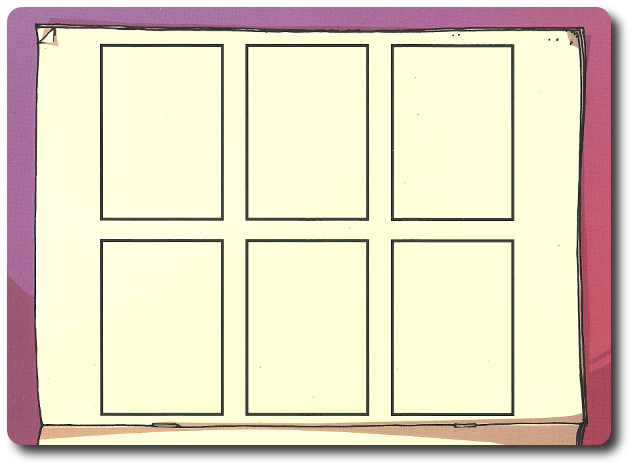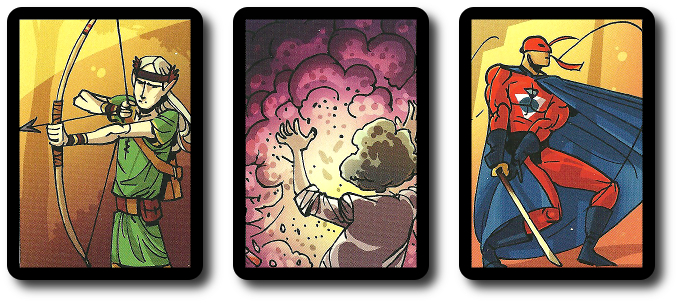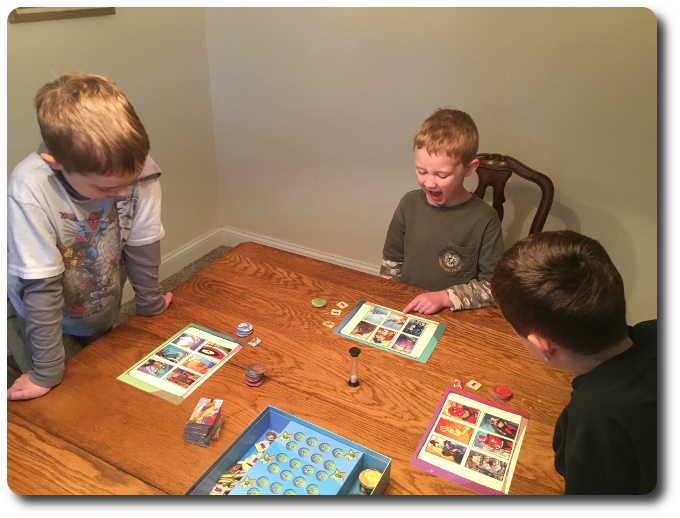
The Basics:
- For ages 6 and up (publisher suggests 8+)
- For 3 to 10 players
- Approximately 30 minutes to complete
Geek Skills:
- Active Listening & Communication
- Counting & Math
- Logical & Critical Decision Making
- Cooperative & Team Play
- Imagination
Learning Curve:
- Child – Easy
- Adult – Easy
Theme & Narrative:
- Creativity is the key to victory
Endorsements:
- Gamer Geek rejected!
- Parent Geek approved!
- Child Geek approved!
Overview
Legendary graphic novel writer Alan Moore said, “It may be true that the only reason the comic book industry now exists is for this purpose: to create characters for movies, board games and other types of merchandise.” One cannot deny that comic books are a great source for ideas. Full of color and creativity, they inspire us to imagine the impossible. In this game, you’ll get to create your own creative comic.
Co-Mix, designed by Lorenzo Silva and published by Ares Games, is comprised of 5 Comic Page mats (double-sided), 150 Panel cards (double-sided), 10 Score tokens, 10 Character tokens, 50 Review tokens (5 for each player), 21 Slow tokens, and 1 sand timer (approximately 90 seconds). The mats and cards are made of thick and sturdy cardstock. The tokens are made of thick cardboard. The illustrations by Matteo Cremona and Max Rambaldi cover everything from fantasy and horror to spies and superheroes. Lots of color, lots of action, and lots of drama. Exactly what you would expect to find in a comic.
Finding the Comic Section
To set up the game, first give each player a Comic Page mat. The mat is double-sided, with 6 panels on one side and 9 panels on the other. Use the 6-panel side if this is your first time playing or want an easier game. Place any Comic Page mats not being used back in the game box.

Example of a 6-panel Comic Page mat
Second, give each player a set of Review tokens, 1 Score token, and 1 Character token that all show the same character. Any Review, Score, and Character tokens not selected are returned to the game box.
Third, each player takes their Score token and places it on the “0” space of the score track. The score track is built into the game box. The player places their Character token in front of them so they remember which character they are using.
Fourth, shuffle the Panel cards and place them next to the score track. This is the Panel draw deck for the duration of the game. Place the sand timer and the Slow tokens by the draw deck at this time, as well.
That’s it for game set up. Time to test your imagination!
The Comic Book Code
Co-Mix is played in 3 rounds and is a mix of simultaneous play, storytelling, and voting. A typical round of game play is summarized here.
Step 1: Prepare the Panels
At the start of every round, the players agree on a title. For example, “The Big Day”. Every player will be building a story and the agreed upon title will help guide each player. A list of example titles are provided if players are unable to think of any or agree upon on. Players can also draw 2 random Panel cards and use those for inspiration.
When the title is decided, a dealer for the round is selected who draws 12 Panel cards per player and deals them out.
Step 2: Script Your Comic
On the count of “3”, each player picks up their Panel cards and begins to script their comic. Each Panel card is double-sided, giving players a lot of options. The goal is to create a story by filling in each of the Comic Page mat panel spaces with 1 Panel card.

While the goal is to create an interesting story, the Panel cards only need to represent key elements, characters, plot twists, and transitions. That is to say, a player need not script every aspect of their story with their cards, but each Panel card must provide something to the story. Be it a major or minor plot point is up to the player. What is not up to the player is the title which was agreed upon before the round began.
The first person who is done building their script shouts “DONE!” and flips over the sand timer. This player can no longer adjust their Comic Page mat. The remaining players now have about 90 seconds to complete their story. When players finish their stories, they shout “DONE!”, as well and cannot adjust their Comic Page mat. The last player to finish their story with time still remaining is given 1 Slow token.
If the sand timer should run out with players still trying to complete their story, each player with 1 or more empty Comic Page mat panels is given 1 Slow token. Then they take the remaining Panel cards in their hand, shuffle them, and randomly place them on the empty spaces until their Comic Page mat is filled. Players are highly encouraged to NOT let this happen to them.
Before the round continues, players discard any remaining Panel cards they have and did not use.
Step 3: Storytelling
Starting with the player who finished their comic first and continuing in turn-order-sequence, each player now tells their story. When telling the story, the player points to the Panel card that is part of the current portion of the story. This can be a sound, a single word, or anything else. Pointing helps the listeners keep track of what the player is talking about and ensures that each Panel card is used in the story. Players should keep their stories short and entertaining. Making stories too long will bore the listeners and make the game drag.
After the player is done telling their story, the next player tells theirs and so on until every player has had a chance to demonstrate their creative skills.
Step 4: Voting
After all the stories have been told, the players now vote. Voting is done using the Review tokens. Each Review token has an icon that represents a specific category. The categories are as follows:
- Most Original Story – this vote should be given to the player who had the most original story.
- Most Exciting Story – this vote should be given to the player who had the story with the most excitement, the most humor, or the most chills.
- Best Composed Story – this vote should be given to the player who had the most well constructed story, complete with a beginning, middle, and end that used the Panel cards to enhance the experience. And let’s not forget about the round’s title, either.
In addition, the players will have 2 “Neutral” Review tokens that do not count towards any category.
Players place their Review tokens face-down next to their opponent’s Comic Page mat. Each player must place at least 1 of their Review tokens in front of each of the Comic Page mats in play, including their own. The players should also vote as sincerely as possible. There is no advantage in not giving an opponent a specific vote if you think they deserve it.
Once all the players are done voting, the next step of the round begins.
Step 5: Scoring
All of the Review tokens are now revealed. All “Neutral” Review tokens are immediately removed and set aside.
Then players group the Review tokens in front of them into the different categories. The player with the most tokens in a specific category will keep those tokens, while all other players will remove any tokens of the same category in front of their Comic Page mat. For example, if Player “A” had 3 “Most Original Story” Reward tokens and Player “B” only had 2, Player “B” would remove their 2 “Most Original Story” Reward tokens, placing them with the previously removed “Neutral” Reward tokens.
Players now count points. For every Reward token in front of then, they earn 1 point. For each Reward token that belongs to the player and is in front of an opponent’s Comic Page mat, they earn 2 points. The points are added and then recorded by moving the Score token on the score track.
This completes the round. Collect all the removed Reward tokens and return them to the correct players. Discard the Panel cards, but keep any Slow tokens the players may have.
The Last Panel
At the end of the final round, the scores are reviewed. The player with the most points wins the game. If there is a tie, the player with the least number of Slow tokens wins. If there is a still a tie, victory is shared.
Game Variants
A few game variants are provided, including a few we made up ourselves.
Forget the Title
Using a title is a good idea if you want to keep everyone on the same page, but it can create stories that are similar. Try playing a round or two without a title. This allows players to come up with their own creative stories that will be very different than their neighbors. Voting and scoring is the same.
Team Play
Group players into teams and have them work together to script their stories. Team members work together during every step, allowing for some truly interesting creative collaboration.
Longer and Shorter Games
I’ve already mentioned using the different sides of the Comic Page panel, but you can also adjust the difficulty and length of the game by adding or removing the total number of rounds of game play. The default is 3 rounds, but players can do as few as 1 or as many as 10.
The Common Thread
This House Rule replaced the title requirement by randomly drawing 1 Panel card that all players had to use in their story. Note that this shared common Panel card was not placed on the player’s Comic Page mat and they still had to fill every panel with one of their cards. During the storytelling step, they had to incorporate the common Panel card into their narrative.
To learn more about Co-Mix, visit the game’s web page.
Final Word
The Child Geeks had a lot fun with Co-Mix, but preferred to skip many of the rules and just enjoy the activity of creating stories. According to one Child Geek, “The game is fun, but I like creating the stories the best.” Which is to say, the core of the game play – the creative component – was the most desirable aspect of Co-Mix. The competitive element was not, but that didn’t stop some of the older Child Geeks from playing the game with all the rules. As one older Child Geek put it, “I think keeping score and voting for stories helps you focus and create a better story.” In this case, the urge to win also urged the spark of creativity to erupt into a bonfire. From very young Child Geeks to the very old Child Geeks (old being around 13 or so), all the Child Geeks enjoyed Co-Mix and voted to approve it.

The youngest Child Geek tells his tale, while his older brothers listen and quietly judge
The Parent Geeks were very pleased with Co-Mix, finding it to be a fun and creative family game. According to one Parent Geek, “I can see this game doing well at the home and in the classroom.” Very true. Co-Mix could easily be used by a Creative Writing or English teacher. As a family game, the Parent Geeks found Co-Mix to be accessible by everyone and enjoyed, but not for long. Only about 2 or 3 rounds were ever played. As one Parent Geek put it, “The game can get pretty long and start to feel stale.” Easily fixed by shortening the number of rounds. Regardless of how long the game was played, it was filled with laughter and hand-clapping. The Parent Geeks voted to approve Co-Mix.
To quote one Gamer Geek, “This is not a game.” The Gamer Geeks found Co-Mix to be a highly subjective and questionable game right from the start. According to one Gamer Geek, “Telling a story is fine, but how you score points is a little iffy. You are supposed to vote for the best, but the best is subjective. I don’t like games where you can’t logically think things through.” Another Gamer Geek said, “The game is pretty much always about the same characters and same plots. It’s pretty boring.” However, the Gamer Geeks did have one interesting thought about Co-Mix. According to one Gamer Geek, “This is a game that will play well with the right crowd. Get a few adults around the table, pour a few drinks, and you could have a lot of fun with this game. Especially with team play.” And so, the Gamer Geeks ended up rejecting Co-Mix, but left the door open for possible party plays in the future.
Co-Mix is a great example of a game that puts emphasis on creative thinking rather than logical or critical thinking. Which is not to say players won’t be logically and critically thinking things through. On the contrary, this game is all about thinking on many different levels. Where the Gamer Geeks lost interest and some of the Child Geeks ignored was the game that is underneath the surface of the creative storytelling. To be honest, the game portion was of little interest to me, but I did like how it encouraged players to always do their best. And perhaps that’s all it really is. By visually keeping score, players can use it to inspire themselves to do better.
The biggest problem with the scoring system, however, is that better storytellers will always win. Always. Co-Mix will let a player who has the lead to keep it, but not necessarily get way ahead. Because players earn more points by voting on others, players will benefit from the winner’s victories, as well. While this is a good idea in theory, in practice it creates something of a wash in the point spread. The only time when this is not true is when you play with Child Geeks who don’t seem to have any real plan when it comes to where they place their Review tokens. As such, the point spread can get a little wacky.
Overall, I enjoyed the game. It’s fun with my kids and has been fun with slightly larger groups. I recommend keeping the rounds to 3 and if you have 6 or more players, you break it up into teams. This will keep the game going and focused on the storytelling. Downtime is a killer in Co-Mix, but it’s necessary so as to allow players to listen to other people’s stories. If everyone was a great storyteller, this wouldn’t be a problem. For most, it’s going to painful if the game is played too long.
If you enjoy games that put emphasis on creativity, where storytelling is the key to successes, and judging a tale on its merits is more than just giving it a thumbs up or down, then do try Co-Mix. The stories you create could be the next big summer blockbuster movie.
This game was given to Father Geek as a review copy. Father Geek was not paid, bribed, wined, dined, or threatened in vain hopes of influencing this review. Such is the statuesque and legendary integrity of Father Geek.



